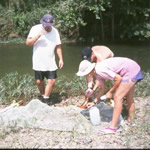|
A brief history of the Oklahoma Biological Survey
The following is condensed from "A history of the Oklahoma Biologcial Survey" by Charles Carpenter.

|
In the 1920's, Dr. Arthur Ortenburger, an early Professor of Zoology at the University of Oklahoma, began a series of expeditions to survey the fauna and flora of Oklahoma. In April 1926, the Oklahoma Wildlife Institute passed a resolution
requesting that the Oklahoma legislature establish a state Biological Survey. The Oklahoma Biological Survey was officially established as a scientific bureau of the University by the Board of Regents in 1927. Aute Richards, Head of the Department of Zoology, became the first director.
|
|
Arthur Ortenburger
|
University of Oklahoma biologists carried out active field expeditions from 1924 - 1936. These expeditions typically were joint ventures between the Biological Survey and the then Museum of Zoology. Animal specimens were deposited in the museum and plants in the Bebb Herbarium (see Bebb Herbarium background). The results of many of these expeditions were published by the Biological Survey itself (see early publications of the Oklahoma Biological Survey). During the severe economic depression of the 1930s and World War II, the field expeditions and publications were discontinued. The last issue of the Biological Survey publication series appeared in 1933.
|
Following World War II the Biological Survey received modest funding that allowed further ecological surveys by biologists such as Drs. George Goodman, Arthur N. Bragg, A.O. Weese, William T. Penfound, Umaldy T. Waterfall, , George M. Sutton, and Carl D. Riggs (Director from 1949-1970). During the 1940's the Biological Survey began a cooperative agreement with the
Oklahoma Department of Wildlife Conservation to operate the Oklahoma Fisheries Research Laboratory.
|

|
|
George Goodman
|
In the 1970's the Biological Survey began new inventories and surveys, benefiting from increased environmental consciousness in the U.S and the energetic activities of the new Director, Dr. Paul Risser (Director from 1971-1978). Dr. Risser brought the
Oklahoma Natural Heritage Program to the Survey with grants from the State Comprehensive Outdoor Recreation Plan in the late 1970's. Also during this time the Biological Survey began computerizing records of the distribution of animals in Oklahoma in conjunction with the then Stovall Museum of Natural History.

|
During the 1980's and 1990's, under the leadership of Dr. Gary D. Schnell (Director from 1978 - 1999), the Biological Survey grew in personnel, research funding, research output, and public service.
In 1987 the state legislature designated the Oklahoma Biological Survey a state agency under the University of Oklahoma Board of Regents. The legislation also re-established the Oklahoma Natural Heritage Inventory and provided permanent funding for four biologists, a data manager, and a secretary.
With the aid of these new biologists and other Survey staff, external research funding grew from $17,000
in 1987 to well over $1,000,000
in 1993 (a 600 fold increase).
|
| 1990's Survey fish crew
| |
|
Survey members published books documenting the distributions and literature pertaining to Oklahoma birds, mammals, reptiles, and plants, as well as numerous journal articles and technical reports (see
Publications of the Oklahoma Biological Survey).
Natural Heritage Inventory biologists' surveys helped to populate the Inventory's database of rare species and community occurrences, which grew from nearly 1,400 records in 1989 to 5,500 records as of 2000. In 1997 the
Sutton Avian Research Center became part of the Biological Survey. Dr. Caryn C. Vaughn became the 5th director of the Survey in July, 1999.
|
 |
|
Caryn Vaughn
|
Photos from the Oklahoma Biological Survey photo archives
Photo credits
This
page is sponsored by the Oklahoma Biological Survey

Disclaimer
|





